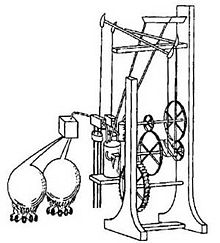John Barber (engineer)
John Barber | |
|---|---|
| Born | 1734 |
| Died | 1793 (aged 58–59) |
| Nationality | British |
| Occupation | Engineer |
| Spouse | Ann Williams |
| Engineering career | |
| Discipline | Engineering |
| Projects | First gas turbine patent |
John Barber (1734–1793) was an English coal viewer and inventor. He was born in Nottinghamshire, but moved to Warwickshire in the 1760s to manage collieries in the Nuneaton area. For a time he lived in Camp Hill House, between Hartshill and Nuneaton, and later lived in Attleborough. The same John Barber is thought to be the inventor named in several patents granted between 1766 and 1792. The most remarkable of these patents was for a gas turbine. Although nothing practical came out of this patent, Barber is recognised as the first person to describe the working principle of a constant pressure gas turbine.
Barber's gas turbine
[edit]
In 1791 Barber took out a patent (UK patent no. 1833 – Obtaining and Applying Motive Power, & c. A Method of Rising Inflammable Air for the Purposes of Procuring Motion, and Facilitating Metallurgical Operations) which contained all of the important features of a successful gas turbine. Planned as a method of propelling a "horseless carriage", Barber's design included a chain-driven, reciprocating gas compressor, a combustion chamber, and a turbine.
Barber's turbine was designed to burn producer gas obtained from wood, coal, oil, or other substances, heated in a retort or producer, from where the gases were conveyed into a receiver and cooled. Air and gas were then to be compressed in different cylinders and pumped into an "exploder" (combustion chamber) where they were ignited, the mixture of hot gas then being played against the vanes of a paddle wheel. Water was to be injected into the explosive mixture to cool the mouth of the chamber and, by producing steam, to increase the volume of the charge.
Legacy
[edit]Given the technologies available to Barber, it is unlikely that a gas turbine could have been built that would have been able to create sufficient power to both compress the air and the gas and produce useful work. It wasn't until 1939, some 148 years after Barber's initial patent, that the first constant pressure gas turbine entered service in Neuchâtel, Switzerland.[1][2]
In the same year that Brown, Boveri & Cie commissioned the Neuchâtel gas turbine the company published an article on the history of gas turbines which acknowledged John Barber's patent.[2] Today, John Barber is widely accepted as being the first person to patent a gas turbine.[3][4][5]
See also
[edit]References
[edit]- ^ Eckardt, Dietrich (2014). "3.2 - Early Attempts with the Gas Turbine Principle". Gas Turbine Powerhouse. Oldenbourg Verlag Munchen. pp. 66–67. ISBN 9783486735710.
- ^ a b Meyer, Adolf (1939). "The Combustion Gas Turbine, Its History, Development and Prospects". The Brown Boveri Review. 26. Baden, Switzerland: Brown Boveri and Company: 130–131.
- ^ Eckardt, Dietrich (2022). Jet Web. Munich, Germany: Springer. p. 100. ISBN 978-3-658-38530-9.
- ^ Young, Steve (January 2019). "Who Invented Industrial Gas Turbines?". NEWSNOC. No. 19. Sharjah National Oil Corporation (SNOC). p. 25.
- ^ Brun, Klaus; Kurz, Rainer (2019). Introduction to Gas Turbine Theory (4 ed.). Solar Turbines Incorporated. p. 15. ISBN 978-0-578-48386-3.
Further reading
[edit]- H. S. Torrens, 'Barber, John (1734–1793)’, Oxford Dictionary of National Biography, Oxford University Press, 2004 Retrieved 29 July 2016
- Cook, Alan F. (July 2003). "JOHN BARBER – The Inventor of the Gas Turbine: A Potted History" (PDF). Nuneaton & North Warwickshire Family History Society – Journal: 10. Archived from the original (PDF) on 20 December 2014. Retrieved 9 March 2008.
- Davey, Norman (2003). The Gas Turbine – Development and Engineering. Watchmaker Publishing. p. 206. ISBN 1-929148-20-8.
